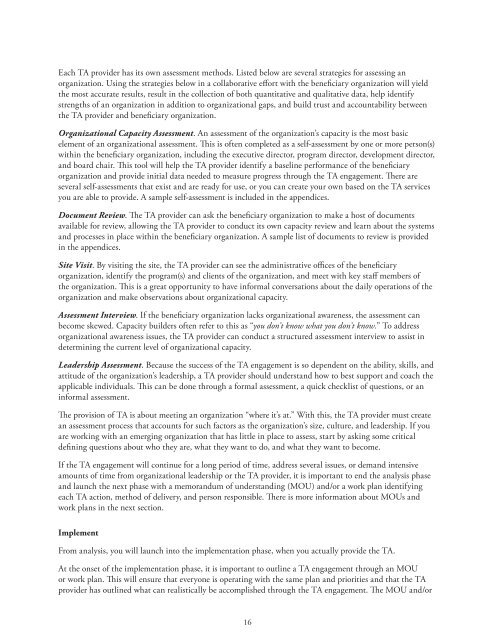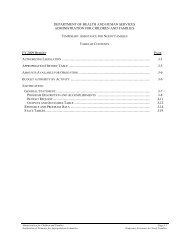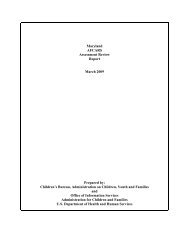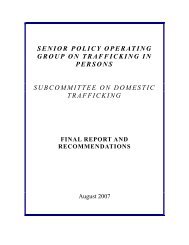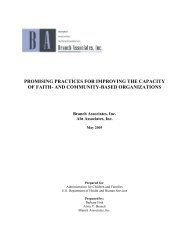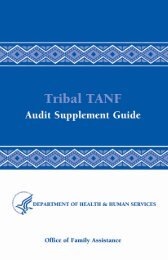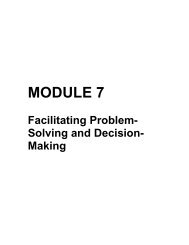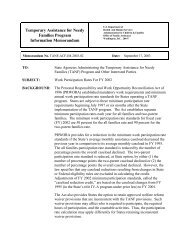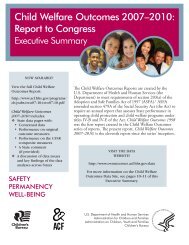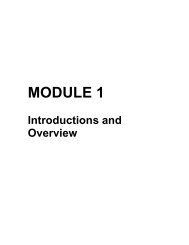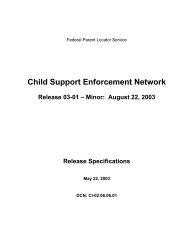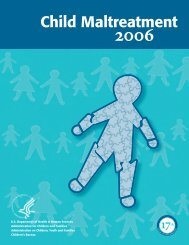Delivering Training and Technical Assistance - Administration for ...
Delivering Training and Technical Assistance - Administration for ...
Delivering Training and Technical Assistance - Administration for ...
You also want an ePaper? Increase the reach of your titles
YUMPU automatically turns print PDFs into web optimized ePapers that Google loves.
Each TA provider has its own assessment methods. Listed below are several strategies <strong>for</strong> assessing anorganization. Using the strategies below in a collaborative ef<strong>for</strong>t with the beneficiary organization will yieldthe most accurate results, result in the collection of both quantitative <strong>and</strong> qualitative data, help identifystrengths of an organization in addition to organizational gaps, <strong>and</strong> build trust <strong>and</strong> accountability betweenthe TA provider <strong>and</strong> beneficiary organization.Organizational Capacity Assessment. An assessment of the organization’s capacity is the most basicelement of an organizational assessment. This is often completed as a self-assessment by one or more person(s)within the beneficiary organization, including the executive director, program director, development director,<strong>and</strong> board chair. This tool will help the TA provider identify a baseline per<strong>for</strong>mance of the beneficiaryorganization <strong>and</strong> provide initial data needed to measure progress through the TA engagement. There areseveral self-assessments that exist <strong>and</strong> are ready <strong>for</strong> use, or you can create your own based on the TA servicesyou are able to provide. A sample self-assessment is included in the appendices.Document Review. The TA provider can ask the beneficiary organization to make a host of documentsavailable <strong>for</strong> review, allowing the TA provider to conduct its own capacity review <strong>and</strong> learn about the systems<strong>and</strong> processes in place within the beneficiary organization. A sample list of documents to review is providedin the appendices.Site Visit. By visiting the site, the TA provider can see the administrative offices of the beneficiaryorganization, identify the program(s) <strong>and</strong> clients of the organization, <strong>and</strong> meet with key staff members ofthe organization. This is a great opportunity to have in<strong>for</strong>mal conversations about the daily operations of theorganization <strong>and</strong> make observations about organizational capacity.Assessment Interview. If the beneficiary organization lacks organizational awareness, the assessment canbecome skewed. Capacity builders often refer to this as “you don’t know what you don’t know.” To addressorganizational awareness issues, the TA provider can conduct a structured assessment interview to assist indetermining the current level of organizational capacity.Leadership Assessment. Because the success of the TA engagement is so dependent on the ability, skills, <strong>and</strong>attitude of the organization’s leadership, a TA provider should underst<strong>and</strong> how to best support <strong>and</strong> coach theapplicable individuals. This can be done through a <strong>for</strong>mal assessment, a quick checklist of questions, or anin<strong>for</strong>mal assessment.The provision of TA is about meeting an organization “where it’s at.” With this, the TA provider must createan assessment process that accounts <strong>for</strong> such factors as the organization’s size, culture, <strong>and</strong> leadership. If youare working with an emerging organization that has little in place to assess, start by asking some criticaldefining questions about who they are, what they want to do, <strong>and</strong> what they want to become.If the TA engagement will continue <strong>for</strong> a long period of time, address several issues, or dem<strong>and</strong> intensiveamounts of time from organizational leadership or the TA provider, it is important to end the analysis phase<strong>and</strong> launch the next phase with a memor<strong>and</strong>um of underst<strong>and</strong>ing (MOU) <strong>and</strong>/or a work plan identifyingeach TA action, method of delivery, <strong>and</strong> person responsible. There is more in<strong>for</strong>mation about MOUs <strong>and</strong>work plans in the next section.ImplementFrom analysis, you will launch into the implementation phase, when you actually provide the TA.At the onset of the implementation phase, it is important to outline a TA engagement through an MOUor work plan. This will ensure that everyone is operating with the same plan <strong>and</strong> priorities <strong>and</strong> that the TAprovider has outlined what can realistically be accomplished through the TA engagement. The MOU <strong>and</strong>/or16


